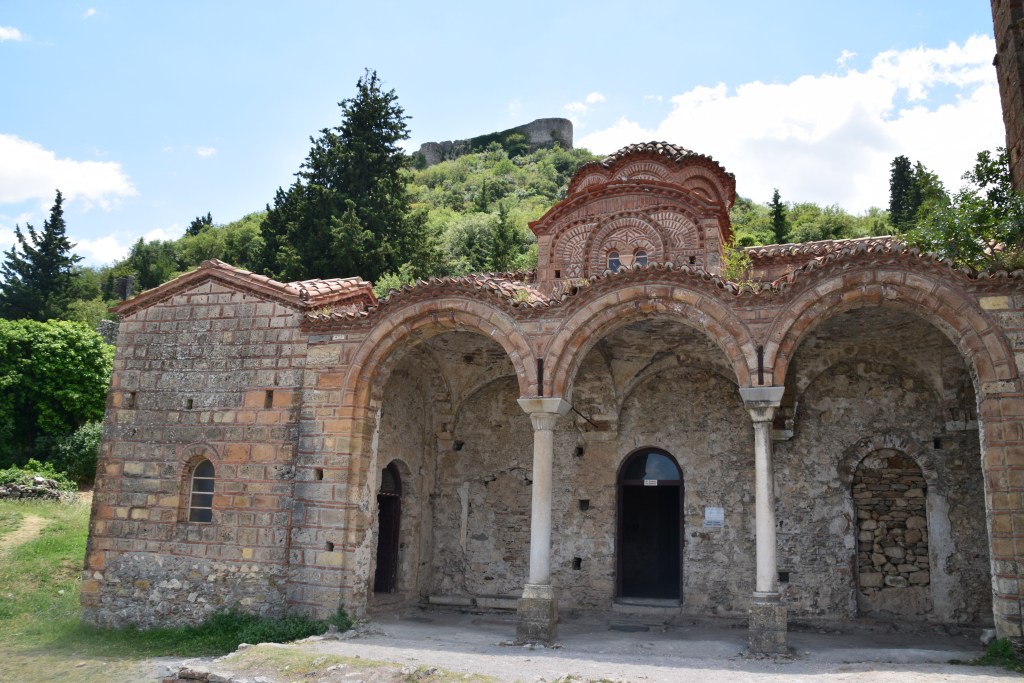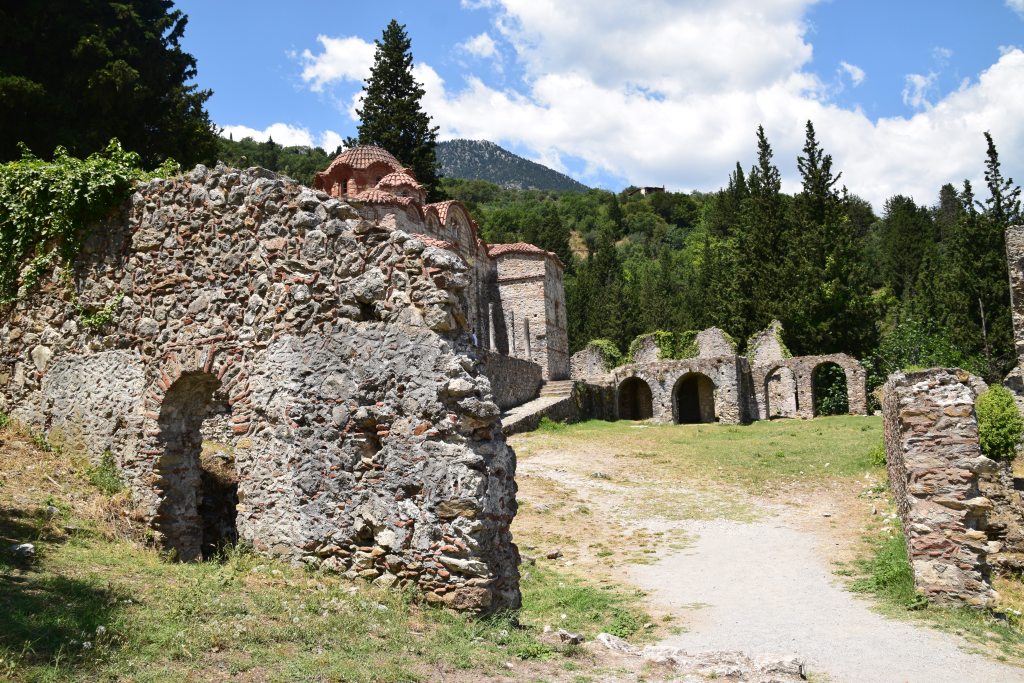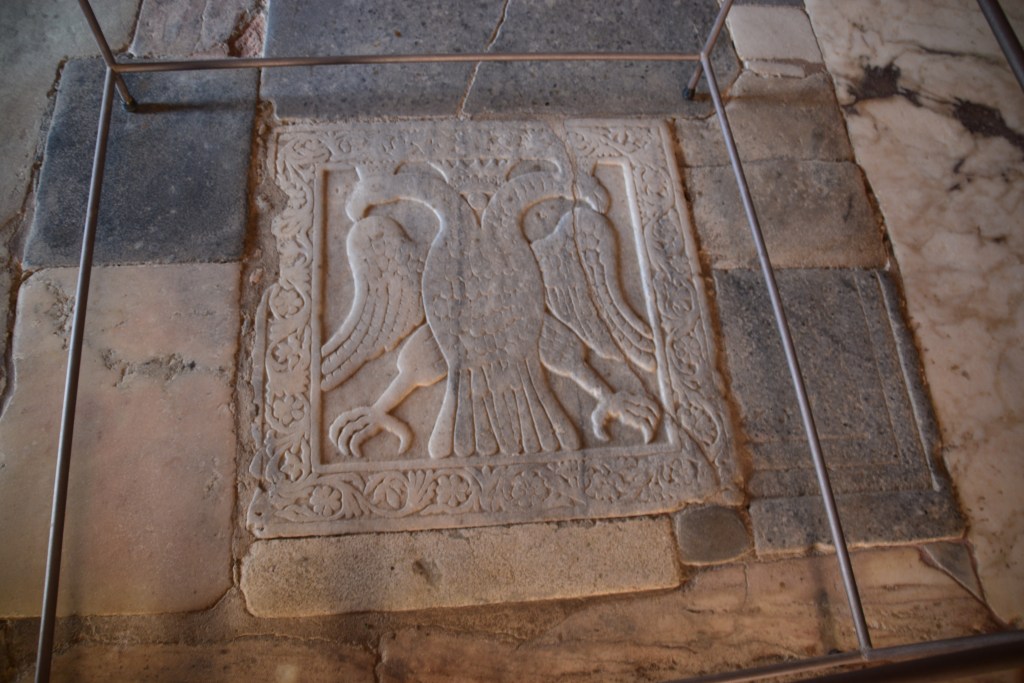Still proudly rising up out of the surrounding plain and dominating the landscape, it’s impossible to walk through the ruined elegance of Mystras and not be drawn back to its glory days as regional capital to an already fading Byzantine Empire …….what a city it must have been!
History in a Nutshell
1204 – The armed expedition of the Fourth Crusade captures Constantinople, the seat of the Byzantine Empire.
The crusaders go on to conquer most of the empire, dividing the spoils among them. Southern Greece goes almost completely to the Latins, or Franks. The Peloponnese – then known as the Morea – goes to the House of Villehardouin.
1249 – William II of Villehardouin decides to build a fortress on top of a hill overlooking ancient Sparta. It offers an ideal vantage point for monitoring the restless residents of the plain below.


Unfortunately for William, he doesn’t have much time to enjoy his castle – the Byzantines are regaining control of the region…
1259 – William is captured in battle and Mystras is ceded to the Byzantine emperor in exchange for his freedom.
1262 – Mystras serves as a provincial capital of the empire, ruled directly from Constantinople – it becomes the centre of Byzantine power in southern Greece.
1349 – The emperor appoints his son Manuel to rule over the Morea as despot.
Trivia Moment: DESPOT was a title bestowed on the sons of reigning emperors.
While the region is still under Byzantine control, its distance from Constantinople pretty much allows for near autonomous rule by the despot.
Mystras becomes the seat of the Despotate of Morea and the city prospers.
1460 – The last Despot of Morea surrenders to Ottoman rule.
Although it has lost some of its grandeur, the city remains an important trading centre and continues to flourish.
Apart from Venetian occupation 1687 – 1715, the Ottomans hold the region until the beginning of the Greek War of Independence in 1821.
The city is so badly damaged during the War of Independence that rebuilding is not the preferred option.
1930’s – The site is abandoned for the newly rebuilt town of Sparta, about 8 km away.
1955 – The last inhabitants leave.
1989 – Inscribed as a UNESCO World Heritage Site.
From the beginning, the inhabitants of nearby ancient Sparta used the castle as a place of shelter and gradually they began to settle and build a city downhill from the fortress. The despots – Manuel and his heirs – secured long stretches of peace with Latin and Ottoman neighbours and prosperity followed.

As the social, political and financial centre of the region, Mystras became home to officers, high clerics and even royalty. It’s almost impossible to imagine this restricted site as home to 20,000 inhabitants at its peak! The city was divided into three parts – the upper town included the original castle and the despot’s palace.

There wasn’t enough space to create separate quarters and districts so rich and poor lived pretty much side by side on the hillside below the castle. The limited space also meant there was no room for plazas and squares apart from an open space in front of the Palace of the Despot which occupied the only tract of flat, level land. Any attempt at formal street planning was impossible and the main thoroughfares were little more than a loose network of alleys – many indeed unable to even accommodate a cart.






With stability and wealth came learning and culture. Even as the Byzantine world was collapsing, Mystras experienced its own cultural renaissance with a flourish of art, writing, architecture and philosophy.
Mystras, even then, was primarily known for its churches. The Bishopric, with its cathedral, had transferred from Sparta. Many monasteries and churches were constructed, mostly in the Byzantine style of overlapping bricks accented with lines of red brick and covered with beautiful frescoes.










Today, the only inhabitants are the nuns who reside in the Pantanassa Monastery. The site includes the fortress, palace, several churches and monasteries, not to mention the incredible frescos which have managed to survive over 700 years of appreciation, attack and abandonment. While much of the site is in ruins, the entrance is well preserved and the Palace of the Despots has undergone significant restoration. The churches and frescoes are fantastic and of course the setting is stunning. There is also a small museum on site.










Small Stuff
Opening Hours
Winter 8.30am – 3.30pm
Summer 8.00am – time varies 6.00pm > 8.00pm
Entrance Fee – €12
Free Admission Days
6th March
18th April
18th May
Last weekend of September
28 October
Access
There are two entrances to the site – many visitors choose to visit the Upper and Lower levels separately and drive in between (same ticket).
A dress code is applied at the Monastery but wraps are provided.
Regardless of whether you go top to bottom or vice versa, the paths are steep and uneven. The ruins are not wheelchair accessible.
Step, steps and more steps!




Before you go….
If you’re thinking of visiting the Peloponnese, then have a look at this…..


Oh wow, this looks amazing and yet I’d never heard of it! Interesting fact about the word ‘despot’ – my little bit of learning for today 🙂 But the highlights here are the beautiful views, the photogenic ruins and those stunning frescoes 😮
How did you find driving around this area? It’s not something we’ve ever contemplated as an option.
I didn’t know about ‘despot’ either! We’d no problem at all Sarah – it worked out very well. It was the end of June however, so not high season. All the sites were quiet and restaurants etc weren’t busy – lovely tables available for sunset drinks and no parking problems. I’m just starting on putting it together for the blog – might have it for next week. We spent four days / nights and could easily have filled a week, even 10 days. It’s very accessible from Athens airport – less than 90 minutes drive. Definitely worth considering…..
How beautiful!
It really is Lyssy – and we’d practically the place to ourselves. It wasn’t high season I know but I don’t think the place gets huge numbers of visitors…
Wow, it’s stunning. Byzantine churches really do just feel like a special piece of history.
We’ve actually seen quite a few in the past year – between Cyprus and Greece – and they’re all so beautiful, even those that haven’t been well maintained…
I would love to visit this beautiful place. Excellent post.
Than you – glad you enjoyed. We’d a wonderful few days – each place we visited was more stunning than the one before… so much to see and do….
Its a lovely little town isn’t it – we’d lunch there after our visit. Glad you enjoyed reliving your own trip!
We visited this place last year – wonderful to explore that ancient city, second only to Constantinople in importance if I remember correctly – and actually wished we’d stayed in the nearby small town. Brings back great memories reading about it again.
Wow this place looks amazing, so beautiful! I am yet to get to Greece but when I do I will keep this place in mind. Thanks!
You’ve seen plenty of the world so far Anna – I’m sure you’ll make it to Greece one day…. XXMarie
This is our kind of trip. Saving this. Thank you!
Hope you make it one day – we’d a great time!